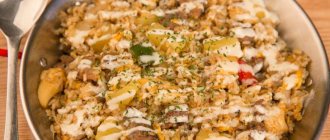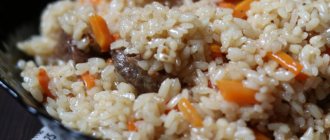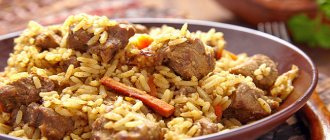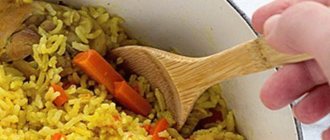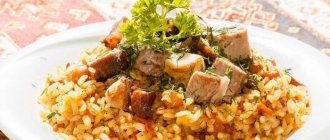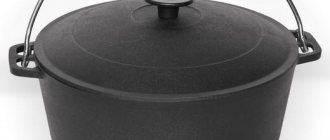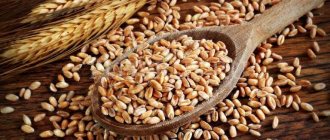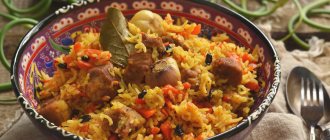This aromatic spice is native to southeastern India. Dishes containing it are popular in Japan, Indonesia, and China, but in our country, turmeric has not gone unnoticed. This natural source of antioxidants, antidepressants, and antibiotics will not only diversify the taste and aroma of the dish, but will also bring considerable benefits to the body. Turmeric is often used for pilaf - it is thanks to it that rice acquires a bright orange color. Today we will tell you how to cook delicious pilaf with turmeric, how much spice you need to add to make the dish excellent.
Why is it added?
This oriental spice adds spice to the dish, enhancing the taste and coloring the rice in a pleasant “sunny” color. The smell of the cooking dish is filled with peppery and woody notes with a hint of musk. In addition, the healing properties of this ingredient have been known for a long time. Being a natural antioxidant and antidepressant, turmeric increases the nutritional value of the dish and has a beneficial effect on the body:
- improves the digestion process;
- restores intestinal microflora;
- increases immunity;
- has a beneficial effect on the blood system.
The spice of the ginger family has earned a place of honor on the shelves of housewives not only for its taste and affordable price, but also for its healing properties.
Interesting to know: more than 40 types of turmeric are known in the world, but only one is suitable for making spices - long turmeric (Curcuma longa). The photo below shows turmeric root.
TOP 5 tricks for preparing pilaf from culinary experts
Key points in preparing proper pilaf:
- Rice . For pilaf you need rice with a low starch content, which will absorb water, fat and aromas well, and also keep its shape when cooked and not stick together. The standard Uzbek pilaf is prepared from Devzira rice. But, as a rule, you need to go to the market specifically to get it. In the store, the most suitable ones will be brown rice, golden steamed, or in extreme cases, you can take long-grain Krasnodar rice. Basmati rice is suitable for Azerbaijani pilaf. Before cooking, rice, except steamed rice, must be soaked for at least 40 minutes in water at a temperature of 60 °C.
- Mature meat . Unlike meat from young animals, mature meat gives zirvak a rich taste and does not fall apart or dry out during long-term cooking.
How much and when do they put it?
Is turmeric added to pilaf? Yes. But how much turmeric needs to be put in pilaf to achieve the ideal taste is a controversial issue. There is no clear answer to this. Dosage varies depending on the recipe chosen and personal preference. Fans of pronounced taste add more. Those who have not yet mastered cooking “by eye” or are not adherents of oriental spiciness add less. No one has canceled the rule of the “golden mean”: add seasoning a little at a time, starting with 1/2 teaspoon. An excessive amount of this oriental spice will spoil the taste and add a “chemical” aroma.
Note<:></:>
You can add spice in different ways: at the stage of stewing meat and vegetables and before adding rice. In the first case, the emphasis is on the taste of the spice during the process of impregnation with zirvak; in the second, turmeric is added to pilaf to achieve a yellow color to the dish.
How to cook “Pilaf with chicken and turmeric”
Prepare your ingredients.
Peel the carrots and onions, rinse and dry the vegetables. Cut the carrots into strips, cut the onion into small cubes.
Rinse and dry the chicken fillet, cut into small pieces.
Heat the oil in a small cauldron, add carrots, onions, chicken, fry for 5 minutes, stirring.
Pour a portion of rice into the cauldron. Add salt, pepper, turmeric and pilaf spices.
Pour two glasses of warm water into the cauldron and mix everything. Place the head of garlic in the center. Simmer the pilaf over low heat for 25 minutes. After a while, take a sample and serve the pilaf to the table.
Enjoy your meal!
The trio of “cumin, barberry, turmeric” in rice cereal dishes with meat.
Pilaf can be prepared from any type of meat using a mix of spices.
Use beef, lamb, pork for a hearty pilaf with a bright meaty taste, turkey and rabbit for a dietary table and delicate taste. The winning trio: cumin, barberry, turmeric, will successfully emphasize the taste of the dish, focusing on its oriental origin.
Barberry will weave in an exotic sourness, and cumin will add a nutty sound, which, together with the bitter-musky taste of turmeric, will create an ideal composition of spices.
The ingredients and cooking steps are the same as the recipe above.
The composition of spices will change; barberry berries, cumin and turmeric are taken 1/2 tsp. In this case, you need to add spices at the stage of stewing vegetables and meat. Zirvak will be saturated with aromatic notes and release them during the cooking process.
Note: zirvak is a broth with stewed vegetables and meat, into which rice is poured.
Recipes
Uzbek pilaf with turmeric
For the perfect Uzbek pilaf, you need to select the best and freshest ingredients.
List of products for pilaf:
Lamb pulp – 800 grams. Ideally, meat from the hind leg of a young lamb.
- Rice – 900 grams. The Devzira variety from the Fergana Valley is considered ideal.
- Carrots – 500-600 grams. Only dense, hard, middle-aged carrots are suitable for pilaf.
- Onions – 500 grams.
- Whole head of garlic.
- Vegetable oil – 100-150 grams.
- Fat tail fat – 100-150 grams.
- Salt - based on the figure.
- Mix of spices for pilaf - ground cumin, barberry, turmeric, garlic.
Preparation procedure:
- Rice is washed with cold water in several stages. And leave it in the water for at least several hours.
- Wash the meat and cut into portions.
- Cut the onion into half rings.
- Chop the carrots into large cubes.
- Cut the roots off the garlic until the cloves are exposed.
Cooking process:
- Fry the fat in a large casserole with a thick bottom. Remove the cracklings and add oil.
- Add the onion to the hot oil and fat and fry well until a nice golden brown crust appears.
- Add meat to the cauldron and fry well until the lamb is browned.
- Add carrot sticks and fry over high heat. Then add a little boiling water and simmer over medium heat with the lid on.
Interesting fact! Stewed meat with onions and carrots after frying is called zirvak!
- Once the meat has become soft, you can add rice. To do this, you need to drain the water from the rice and carefully spread it on the surface of the zirvak.
- Sprinkle a thin layer of seasoning on top. Add a head of garlic to the rice. Add one tablespoon of salt per kilogram of rice.
- Can be filled with water. The main thing is to do this carefully. There are two ways to add water without disturbing the surface of the rice.
- Next, cook using a slotted spoon. Turn the slotted spoon over with the curved side up and carefully pour water onto the slotted spoon. The water will flow onto the rice in thin streams and will not damage the surface.
- Using a knife. Unfold the knife with its flat side. The tip of the knife should be directed towards the wall of the cauldron in which the dish is prepared. Carefully pour water onto the knife so that the water flows from the knife onto the walls of the cauldron.
- The water level should slightly cover the grain. One centimeter maximum.
- DO NOT INTERFERE! Ideal pilaf after adding grain does not interfere, then it turns out more crumbly.
- Cover and place over high heat.
- After the water boils, simmer over low heat for 30 minutes.
- After 30 minutes, open the lid of the cauldron and let the steam escape. Remove the head of garlic. Mix the cooked rice with the meat and cover. So that the rice absorbs the flavor of the meat.
- The pilaf is ready, you can put it on a large dish and garnish it with herbs and a head of garlic.
Video recipe for pilaf with turmeric
Iranian pilaf with turmeric, orange and almonds
Such an unexpected combination of products will surprise guests and give the hostess compliments. You need to prepare such pilaf with love and be sure of a tasty result. This dish is strikingly different from the usual pilaf, because the meat is cooked separately from the rice.
For Iranian pilaf prepare:
- Basmati rice – 1000 grams.
- Onions - 2-3 heads.
- Carrots – 1000 grams.
- Orange – 2 pieces.
- Almonds – 100 grams.
- Black raisins – 100 grams.
- Dried apricots – 100 grams.
- Pistachios – 100 grams.
- Flour – 100 grams.
- Salt and sugar - ½ teaspoon each.
- Saffron – 1 pinch.
- Ghee butter – 150 ml.
- Water – 100 ml (50 ml cold and 50 ml hot).
Haresh sauce:
Turmeric – 1 teaspoon.
- Coriander – 1 tablespoon.
- Zira – 1 teaspoon.
- Vegetable oil – 150 ml.
- Black pepper.
- Lamb meat on the bone – 1.3 kilograms.
Prepare ingredients:
Chop the carrots into small strips.
- Divide dried apricots into 4 parts, set aside a little for decoration
- Mix saffron and sugar and pour a glass of boiling water
- Place Basmati in freshly boiled water and cook for no more than 20 minutes. Pour into a colander and rinse well with running ice water. The rice should not have time to fully cook.
- Mix flour and salt, add 3 tablespoons of water, knead into a thick dough. And roll it out thinly into a round cake. Fry without oil until done.
- Remove the skin from the citrus fruits and chop thinly.
- Pour a little melted butter into a frying pan, fry the raisins in the oil until they swell and remove, add a little more oil and fry the almonds for 1-2 minutes.
- Adding oil as needed, fry the pistachios, dried apricots and carrots.
- Fry the orange zest in the remaining oil until fragrant, about 30-40 seconds.
Cooking process:
- Grease the bottom of the cauldron with melted butter, using a pastry brush, lay out the flatbread, smoothing the edges.
- Grease the flatbread and top with ¾ of the rice.
- Place nuts, zest, carrots, raisins and dried apricots in an even layer on the basmati and cover with the remaining rice.
- Pour the remaining oil into the center of the rice.
- Pour the saffron and sugar mixture along the edge of the rice. Thanks to this watering, it will be colored in parts and will have a beautiful velvety shade.
- Cover tightly and set over high heat. As soon as the cauldron warms up, remove the heat and cook for 50-60 minutes.
How much turmeric is needed for pilaf
How much turmeric to add to pilaf depends on two factors: the data in the recipe and personal preference. But even if you are an avid lover of this spice, there is no need to overdo it with its quantity. Firstly, it can spoil the taste of pilaf, making it bitter, and secondly, it will negatively affect your health.
Depending on the presence of other seasonings in the pilaf, it is suggested to take turmeric at the rate of: 1/3 – 1 tsp. per kilogram of rice. It is worth clarifying that the data refers to turmeric in its pure form, and not as part of other spices. To add a light aroma, spice is added “at the tip of the knife.”
Turmeric is contraindicated for diseases of the gastrointestinal tract - therefore, people with such pathologies should avoid this seasoning in any quantity!
Preparation
- Place a cauldron or other thick-walled dish on high heat and heat it up.
- Place the lard cut into pieces into it and melt, reducing the heat to low.
- Remove the roast, sprinkle with thinly sliced onion and eat. And add onion, cut into half rings, into the melted fat and fry over high heat until beautifully browned. The onion should be fried, it will give taste and color to the dish!
- While the onions are frying, chop the meat. If it is old, then the pieces should be smaller. If the lamb or beef is young, then the pieces are larger, they will boil faster, and you will have to keep the meat on the fire for quite a long time.
- Immerse the chopped meat into well-fried onions.
Don't worry about the onions burning with the meat. This will not happen, because the meat will reduce the heat in the cauldron, and itself will begin to fry at 120 degrees.
